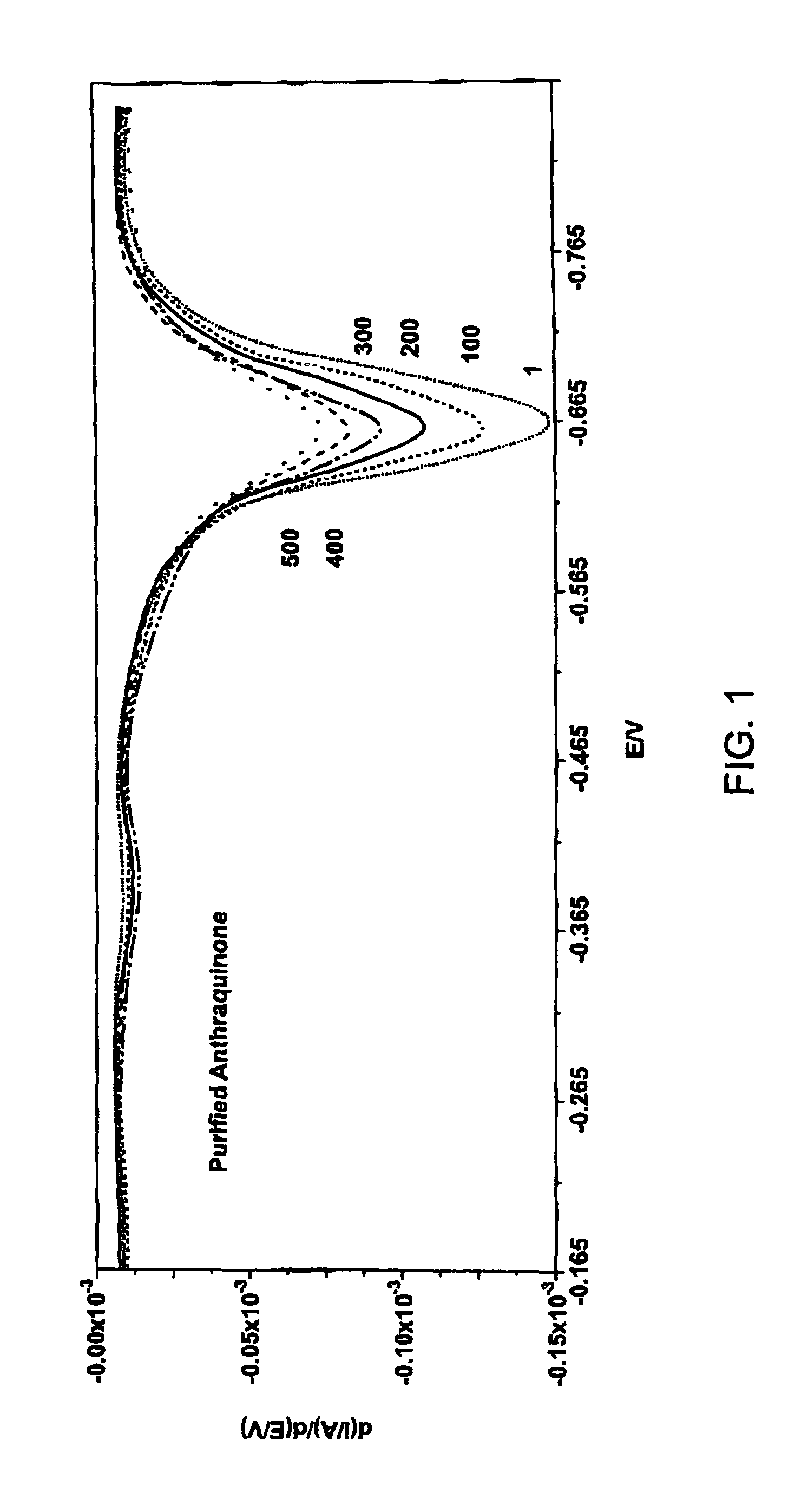Device for detecting an analyte
a technology for detecting analyte and glass electrode, which is applied in the field of detecting analyte, can solve the problems of limiting the applicability field of glass electrode, unstable calibration curve, and accuracy and reliability of traditional ph glass electrode, and achieves easy and inexpensive construction, high peak position stability, and long service life.
- Summary
- Abstract
- Description
- Claims
- Application Information
AI Technical Summary
Benefits of technology
Problems solved by technology
Method used
Image
Examples
example 3
WE ASM Example 3
Huisgen 1,3-Dipolar Cycloaddition to Functionalized Substrate Synthesis of 2-(3-ethynylphenol)methylanthraquinone
[0168]2-(Bromomethyl)anthraquinone (0.200 g, 0.664 mmol) and 3-hydroxyphenylacetylene (0.086 g, 0.731 mmol) and tetrabutylammonium iodide (0.020 g, 0.054 mmol) were taken up in acetone (20 mL). K2CO3 (0.119 g, 0.863 mmol) was added in one portion and the reaction vial was sealed. The reaction mixture was heated in a heating block (60° C.) while stirring over the weekend. The following Monday morning, the reaction mixture was cooled to ambient temperature. The solution was diluted to a total volume of 40 mL by addition of aqueous 0.1M NaOH solution. The resulting precipitate was collected on a Büchner funnel. The resulting solid was taken up in dichloromethane and was adsorbed onto silica gel for loading onto an Isco cartridge (40 g, silica gel). The material was eluted using 10% EtOAc in hexanes (500 mL) followed by 15% EtOAc in hexanes as the eluent. The ...
example 4
Fabrication of WE with Luer Connector
[0171]A preferable WE of the present invention was fabricated as follows. Referring to FIG. 19, a gold-plated spring 106 was inserted into tip housing 36 and allowed to rest on a ledge in the tip housing. A portion of graphite rod 42 (0.120″ diameter, Graphite Sales, Inc.) was then inserted into plastic housing 36 machined to accommodate less than the length, but the entire diameter of the rod with a friction fit at all points except near one end of the housing. In this arrangement the rod 42 makes direct electrical contact with spring 106. Annular gap 124 was filled with epoxy (Epotek, Billerica, Mass.) and cured according to the epoxy manufacturer's instructions. The protruding portion of the rod-epoxy construct was then sanded flat using first 220 grit and then 1200 grit sandpaper yielding a flush plastic-epoxy-graphite surface.
[0172]The freshly sanded tip was dusted with a stream of nitrogen to remove particles, immersed in acetonitrile (BDH)...
example 1
pH Sensor Assembly
[0193]Referring now to FIGS. 14-19, a probe assembly 201 is provided incorporating various electrodes arranged in a coaxial configuration. In some embodiments, probe assembly 201 include a working electrode (WE) comprising a redox-active analyte sensitive material (ASM), a counter electrode (CE) comprising an electrically conductive carbon-fiber tube, and a reference electrode (RE) comprising a chloridized silver wire surrounded by an electrolytic solution, as shown in FIG. 15 and FIG. 18. The pH metering system 101 directly measures proton concentration within a sample solution by electrochemically inducing a reversible chemical reaction on the ASM of the WE. Once the WE, CE and RE are immersed in the sample solution, a voltage sweep is passed through the CE which causes the ASM of the WE to undergo a redox reaction thereby gaining or losing electrons. The resulting flow of electrons is recorded by the pH processor module.
[0194]In one aspect, the present invention...
PUM
| Property | Measurement | Unit |
|---|---|---|
| pH | aaaaa | aaaaa |
| total volume | aaaaa | aaaaa |
| pH | aaaaa | aaaaa |
Abstract
Description
Claims
Application Information
 Login to View More
Login to View More - Generate Ideas
- Intellectual Property
- Life Sciences
- Materials
- Tech Scout
- Unparalleled Data Quality
- Higher Quality Content
- 60% Fewer Hallucinations
Browse by: Latest US Patents, China's latest patents, Technical Efficacy Thesaurus, Application Domain, Technology Topic, Popular Technical Reports.
© 2025 PatSnap. All rights reserved.Legal|Privacy policy|Modern Slavery Act Transparency Statement|Sitemap|About US| Contact US: help@patsnap.com



